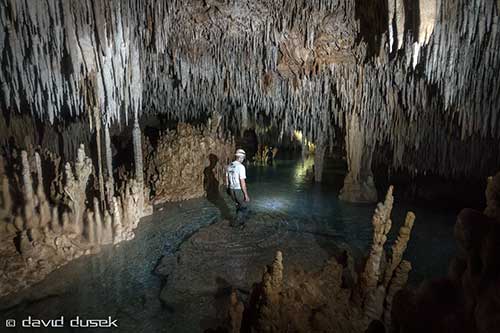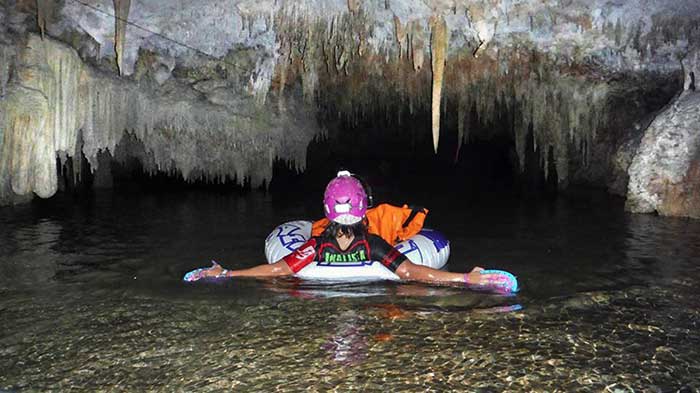By John Pint
 I
have been exploring caves for nearly 50 years and the easiest question
I’ve ever had to answer about the subject is: “What is the world’s
longest cave?” I
have been exploring caves for nearly 50 years and the easiest question
I’ve ever had to answer about the subject is: “What is the world’s
longest cave?”
Mammoth Cave in Kentucky—presently 651.8 kilometers (405 miles) in
length—has always been so far ahead of any other long cave on the
planet that it seemed a sure thing that a challenger would never arise.
Chris
Lloyd in Box Chich Tan Cheé (Laughing Grackle Cave), located in Quintana Roo. Photo by David Dusek.
So you can imagine my surprise and disbelief when my friend, Canadian
geologist Chris Lloyd, casually remarked that a cave he’s been helping
to survey near Playa del Carmen, on Mexico's Yucatán Peninsula, will
“without a doubt, eventually be recognized as the world’s longest.”
Lloyd has been working for years in an area called Pool Tunich, which
means Belly Button in Mayan. The project leader is U.S. Cave
cartographer Peter Sprouse and he and all the group members are
volunteers. Pool Tunich is located smack in the center of Río Secreto,
the most popular tourist cave in Quintana Roo. “Río Secreto,” says the
geologist, “is a very beautiful cave with about 16 entrances and the
tour operators take people in one entrance and out another, meaning
that one tour group hardly ever bumps into another, allowing visitors
to feel they are alone in the cave.”

Elsi
Lara floats blissfully near the Tres Escalones entrance of Sistema Pool
Tunich, which means The Belly Button in Mayan. Photo by Chris Lloyd.
“During this year’s
surveying expedition, we had six cave divers helping us to connect
several dry caves,” says Lloyd. “It was a regular United Nations of
cave divers. We had people from Austria, Finland, Italy, France and
maybe one or two from the United States. Thanks to them, we added four
kilometers of passages to the total distance we’ve surveyed so far.”
Four kilometers didn’t sound like much to me until Lloyd clued me in on
the bigger picture. Peter Sprouse, he told me, has often stated that
“There’s only one cave in Quintana Roo—it’s just a question of
connecting the pieces.” Most of the area’s caves, I learned, are under
water and numerous cave divers have been measuring the lengths of these
water-filled passages for years. When Peter Sprouse’s “dry cavers” come
along and connect one underwater cave to another, the results can be
staggering. For example, in 2012, Sistema Dos Ojos was connected to
Sistema Sac Actún. “We surveyed 200 meters of passage that happened to
be in a key spot,” commented Lloyd, “and the result was a cave 335
kilometers long, now officially recognized as the second-longest cave
in the world.”
If you look at Bob
Gulden’s list of the World’s Longest Caves, you’ll notice
that—in addition to the Sac Actún System—there are seven more
Quintana Roo caves further down the list. If you were to add the
lengths of these to Sac Actún, you’d have a single cave 768 kilometers
long, surpassing the length of Mammoth Cave. If that’s not enough to
convince you, note that the Quintana Roo Speleological Survey (QRSS)
has an archive of survey data for over 353 underwater caves in this
area. That makes a total of 1376.5 kilometers of passages, all of which
may simply be pieces of “one big cave” if Peter Sprouse is right. It’s
just a case of time, say those in the know.
If you don’t feel like waiting for that to happen, you can
still have the pleasure of visiting a Quintana Roo Cave.
Just head for Cancún and sign up for one of the many tours through Río Secreto.
What’s it like inside a Quintana Roo “dry” cave?
“First of all,” says Chris Lloyd, “you have to understand that in this
area ‘dry cave’ means ‘no tanks are required to visit it.’ So tourists
are given a wet suit to wear and a life jacket if they can’t swim.”
The entrance to Pool Tunich is 50 meters wide and eight meters high.
“It’s dramatic,” says Lloyd. “You go down stone stairs that were placed
there by the Mayans 2000 years ago. Soon you are in a knee-deep pool of
warm water connected to the main aquifer. It’s all water, wall to wall.
The floor you are walking on is actually a platform created by calcite
deposits. This can have holes in it, so if you’re not paying attention,
you can suddenly find yourself swimming. The water is crystal clear and
you’ve got little catfish swimming around in there because it’s
connected to the main water table, and if you’re lucky, you may spot
little blind shrimp or you might find a tarantula that fell into the
cave through one of the many skylight entrances.
"Occasionally
you’ll see small eels among the root balls, which are from roots that
have drilled through the limestone roof, which is only one or two
meters thick. These dangle in the cave until they finally hit water.
Once they reach it, they have all the water and nutrients they need, no
matter how dry it gets up on the surface. Occasionally the roots get
coated by calcite and are transformed into shimmering columns. Of
course these caves have other kinds of decorations: stalactites,
stalagmites and flowstone, generally white but sometimes
multicolored...and all of it is clean and sparkling; so this is one
cave where you come out not muddy but cleaner than when you went in.”
Are you interested in visiting Río
Secreto? Better hurry, because once Mexico becomes
host to the World’s Longest Cave, the price of a tour will probably
double.
|

